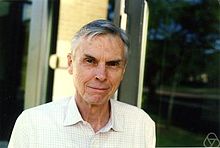John Torrence Tate Jr.
| John Tate | |
|---|---|
 |
|
| Born | John Torrence Tate, Jr. March 13, 1925 Minneapolis, Minnesota, U.S. |
| Nationality | American |
| Fields | Mathematics |
| Institutions |
Princeton University (1950–1953) Columbia University (1953–1954) Harvard University (1954–1990) University of Texas at Austin (1990–2009) |
| Alma mater | Harvard University (A.B., 1946) Princeton University (Ph.D., 1950) |
| Doctoral advisor | Emil Artin |
| Doctoral students |
Ki-Seng Tan V. Kumar Murty Edward Assmus Theodore Chinburg William C. Waterhouse Benedict Gross Jonathan Lubin Stephen Lichtenbaum Kenneth Alan Ribet Joseph H. Silverman Dinesh Thakur Jerrold Tunnell Robert Warfield Carl Pomerance George Bergman |
| Known for |
Tate conjecture Tate module |
| Influenced | John H. Coates |
| Notable awards |
Abel Prize (2010) Wolf Prize (2002/03) Steele Prize (1995) Cole Prize in Number Theory (1956) |
John Torrence Tate, Jr. (born March 13, 1925) is an American mathematician, distinguished for many fundamental contributions in algebraic number theory, arithmetic geometry and related areas in algebraic geometry. He is professor emeritus at Harvard University. He was awarded the Abel Prize in 2010.
Tate was born in Minneapolis. His father, John Tate Sr., was a professor of physics at the University of Minnesota, and a longtime editor of Physical Review. His mother, Lois Beatrice Fossler, was a high school English teacher. Tate Jr. received his bachelor's degree in mathematics from Harvard University, and entered the doctoral program in physics at Princeton University. He later transferred to the mathematics department and received his PhD in 1950 as a student of Emil Artin. Tate taught at Harvard for 36 years before joining the University of Texas in 1990. He retired from the Texas mathematics department in 2009, and returned to Harvard as a professor emeritus. He currently resides in Cambridge, Massachusetts with his wife Carol. He has three daughters with his first wife Karin Tate.
Tate's thesis (1950) on Fourier analysis in number fields has become one of the ingredients for the modern theory of automorphic forms and their L-functions, notably by its use of the adele ring, its self-duality and harmonic analysis on it; independently and a little earlier, Kenkichi Iwasawa obtained a similar theory. Together with his teacher Emil Artin, Tate gave a cohomological treatment of global class field theory, using techniques of group cohomology applied to the idele class group and Galois cohomology. This treatment made more transparent some of the algebraic structures in the previous approaches to class field theory which used central division algebras to compute the Brauer group of a global field.
...
Wikipedia
